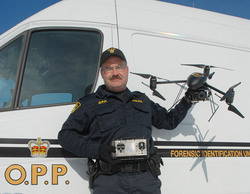The Council for Scientific and Industrial Research (CSIR) has unveiled its unmanned air vehicle (UAV) simulator, which provides real-time man-in-the-loop simulation of UAV flights.
The simulator will serve as a research facility. "It is a tool that has lots of applications," says CSIR Principal Engineer for modelling, simulation and UAVs John Monk.
"With it, we can do research on flight control algorithms. The simulator will soon be loaded with helicopter flight simulation software, so we will also be able to do research on rotary-wing flight algorithms as well as on fixed-wing flight algorithms. It is a capability we can use to test any UAV design before we actually fly the prototype."
The simulator forms part of what is being called the National Unmanned Air Systems Research Infrastructure. This also includes CSIR designed UAVs - notably, but not exclusively, the Modular UAV, also known as the Meraka UAV (see Engineering News January 30, 2009) - wind tunnels and propeller test rigs.
"With this simulator, we hope to continue our long-term research cooperation with the University of Stellenbosch," he adds - Stellenbosch developed the autopilot for the Modular UAV and has a rotary-wing UAV project. The simulator can also be used to train UAV operators.
The simulator makes use of different hardware and software systems acquired by the CSIR. These were then integrated into a single system by researchers in the CSIR's Defence, Peacekeeping, Safety and Security (DPSS) unit.
"The simulator uses four personal computers (PCs), of which one runs the flight simulation package, also known as the flight dynamics model, which was bought from a Canadian company, Presages. We added an open source simulation package, which was slightly modified by us, for the visuals," explains Monk.
"The system can use three screens, one per PC, to display the visuals - the screen of the fourth PC is used to monitor the system. These screens can be either big or small or a combination. To maintain graphics quality, we operate separate but identical graphics software on each of the three display PCs; one acts as a master, with the others slaved to it."
The current simulator is unofficially known as Version 1.0, and it was developed using CSIR DPSS Aeronautics group technology development funds. The simulator could be developed to fulfil many additional functions, if additional funding was provided.
Meanwhile, in a separate but parallel project, DPSS researchers will integrate an electro-optical payload on to the Modular UAV in the near future. "There is a lot of research into electro-optical systems within the DPSS," elucidates CSIR DPSS aerospace contract research and development manager John Wesley.
"For example, into digital image enhancement, image stabilisation, and target identification and tracking. The Modular UAV allows us to take a low-cost payload and to do more realistic research."
Hitherto, the researchers have had to use static installations like buildings and towers as the platforms from which to conduct their research into electro-optical payload systems. By flying one on the UAV, they will be able to do the realistic research in a fully representative environment needed to advance to the next stage of development.
The payload that is in the process of being integrated onto the UAV is being supplied by specialist South African company Tower35.
"We're a small development company, and our objective is to take stabilised cameras, basically military systems, and adapt them to new, civil, applications, especially commercial and industrial," says company MD Pieter van Jaarsveld.
"To access these markets, these systems must be made lighter, simpler, and cheaper. Our objective is for our systems to be half the weight and half the cost of our competitors."
The payload being integrated with the Modular UAV is a 1,2-kg system comprising a daytime zoom digital camera, with a three gimbal mounting, stabilised in two axis (azimuth and elevation).
The complete system is 125 mm in diameter.It is a self-contained modular unit, referred to as a gimbal, and will be directly attached to the central pod of the UAV.
It has a real-time data link to a ground station, which is equipped with an antenna that automatically follows the UAV. The camera can be controlled in real time from the ground. The camera system and the UAV can be controlled separately and simultaneously. It is hoped to demonstrate this system on the UAV by the middle of next month (April).
Tower35 was contracted by the DPSS to provide this payload. This digital camera system has already been flown on manned aircraft, but this will be its first application for UAVs.
Tower35 has produced a number of such systems, of different sizes and capabilities, mostly for airborne applications, but they can also be mounted on vehicles, and one is installed at a race course.
"We have a fairly advanced 350 mm diameter gimbal, three axis stabilised (azimuth, elevation, and roll), five gimbal mounting, containing a high-definition two-thirds of an inch charge coupled device TV camera, with a big lens," cites Van Jaarsveld.
"It is for high-end TV and weighs 25 kg - our competitors' systems typically weigh 40 kg."















